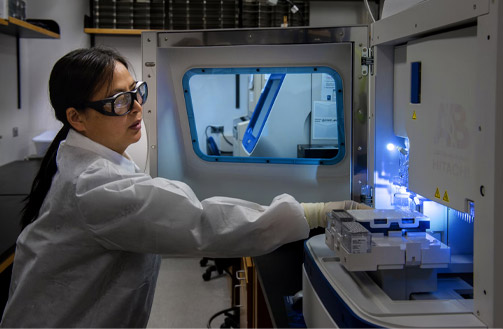
Blog
5 Uses of Wastewater Data for COVID-19 Responses

February 1, 2023
Since the start of the pandemic, wastewater monitoring has provided vital insight into the spread of COVID-19 within communities and across the country. In this document, we share examples of how wastewater monitoring programs have informed effective responses to COVID-19.

1. Detect Disease Presence and Assess Trends
- Detect new outbreaks early and comprehensively track known variants and disease burden, independent of fluctuations in clinical data and at-home test use
- Strategize community-wide public health interventions (mask mandates, indoor dining closures, etc.) and evaluate their effectiveness over time
- Adjust public health messaging
- Investigate impacts on disproportionately affected communities
2. Disseminate Comprehensive, Community-Wide Data to the Public
- Leverage Biobot’s COVID-19 Dashboard, which includes county and national COVID-19 and variant data that is representative of tens of millions of people across the country
- Publish wastewater data on a public dashboard (and raise awareness via social media)
- Biobot’s data on the Massachusetts Water Resources Authority’s dashboard became a pivotal public health resource at the outset of the Omicron wave
- Annotate dashboard with levels of concern, trends, or local events
- The Ohio Coronavirus Wastewater Monitoring Network uses colored arrows to indicate changing trends in wastewater levels
- A wastewater dashboard for Tempe, AZ includes an “event timeline”, which overlays public health measures (e.g. school openings) next to wastewater trends
- Share results directly with key stakeholders to help inform public health measures and health system capacity planning
- Government officials
Maine CDC receives Biobot wastewater data directly to inform statewide public health planning - Local hospitals and healthcare systems
Boston Children’s Hospital rescheduled elective surgeries when the Omicron wave was peaking, citing the spike in wastewater data. - Schools
Cambridge Public Schools used wastewater data as 1 of 3 indicators to inform shifts between in-person and remote learning - Testing centers; community clinics; congregate-living settings (drug treatment centers, jails, homeless shelters, senior homes)
- Local media outlets
The Greenfield Recorder (MA) uses Biobot wastewater data to update its community on COVID-19 levels and recommended health measures.
- Government officials
3. Inform Targeted, Neighborhood-Level Interventions and Outreach
- Target mobile testing unit deployment
- In New Castle, DE, wastewater testing on a neighborhood-level enables officials to detect localized spikes and focus diagnostic testing resources
- Organize community outreach programs
- Pop-up vaccination clinics, contact tracing programs, text alerts, neighborhood listservs, multilingual educational materials, face mask distribution
Houston, TX officials found high levels of COVID-19 in a predominantly Hispanic neighborhood’s wastewater. They then deployed clinical testing, cleaning supplies, and multilingual educational materials about COVID-19 and vaccination. With regular testing established in a local church and promoted by its priests, the community’s wastewater levels soon decreased.
- Pop-up vaccination clinics, contact tracing programs, text alerts, neighborhood listservs, multilingual educational materials, face mask distribution
4. Incorporate Building-Specific Testing
- Detect COVID-19 presence early and minimize operational disruptions
- Assess the performance of existing mitigation strategies
- Develop risk thresholds that trigger certain action steps
- For example, certain SARS-CoV-2 concentration ranges can trigger commensurate levels of individual clinical testing or increased HVAC operations
- Implement building-specific wastewater monitoring in the following settings:
- Businesses
Wastewater detections at corporate campuses can trigger incident reports and inform COVID-19 regional risk metrics
- Businesses
- Implement building-specific wastewater monitoring in the following settings:
- Universities
At Rollins College, dorms with high wastewater levels triggered “pop-up” clinical testing; infected students were quickly identified and isolated - At Rollins College, dorms with high wastewater levels triggered “pop-up” clinical testing; infected students were quickly identified and isolated
The Sheriff for Middlesex County, MA explained that Biobot’s data provides “an additional layer of crucial information” and validates the effectiveness of existing mitigation measures at the Middlesex Jail
- Universities
5. Support Arguments for Investments in Public Infrastructure
- Elevate wastewater infrastructure’s role in public health emergency management to municipal officials
Written by Biobot Analytics
Biobot provides wastewater epidemiology data & analysis to help governments & businesses focus on public health efforts and improve lives.





